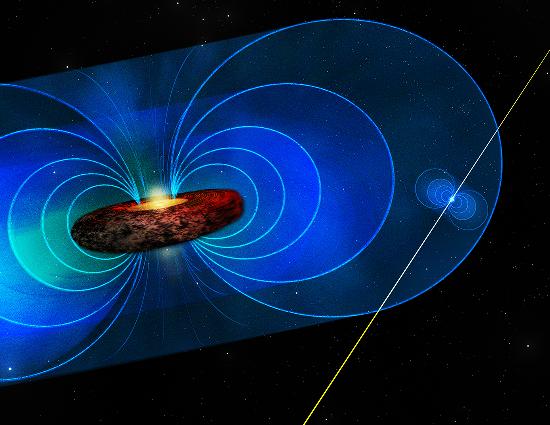Embargoed For Release: 1 p.m., EDT, Wednesday, 14 August 2013
Contact:
Dave Finley, Public Information Officer
Socorro, NM
(575) 835-7302
dfinley@nrao.edu
Newly Found Pulsar Helps Astronomers Explore Milky Way's Mysterious Core
Astronomers have made an important measurement of the magnetic field emanating from a swirling disk of material surrounding the black hole at the center of our Milky Way Galaxy. The measurement, made by observing a recently-discovered pulsar, is providing them with a powerful new tool for studying the mysterious region at the core of our home galaxy.

Full Caption JPEG file (511KB) TIFF file (25.3MB) |
Like most galaxies, the Milky Way harbors a supermassive black hole at its center, some 26,000 light-years from Earth. The Milky Way's central black hole is some four million times more massive than the Sun. Black holes, concentrations of mass so dense that not even light can escape them, can pull in material from their surroundings. That material usually forms a swirling disk around the black hole, with material falling from the outer portion of the disk inward until it is sucked into the black hole itself.
Such disks concentrate not only the matter pulled into them but also the magnetic fields associated with that matter, forming a giant, twisting magnetic field that is thought to propel some of the matter back outward along its poles in superfast "jets."
The region near the black hole is obscured from visible-light observations by gas and dust, and is an exotic, extreme environment still little-understood by astronomers. The magnetic field in the central portion of the region is an important component that affects other phenomena.
The first link to measuring the magnetic field near the black hole came last April when NASA's Swift satellite detected a flare of X-rays from near the Milky Way's center. Observers soon determined that the X-rays were coming in regular pulses. Follow-on observations with radio telescopes, including ones in Germany, France, and the National Science Foundation's Karl G. Jansky Very Large Array (VLA), showed radio pulses identically spaced. The astronomers concluded the object, called PSR J1745-2900, is a magnetar, a highly-magnetized pulsar, or spinning neutron star.
The pulsar is the closest yet found to the black hole, possibly within less than half a light-year. Analysis of the radio waves coming from the pulsar showed that they are undergoing a dramatic twist as they travel from the pulsar to Earth. Such a twist, called Faraday rotation, comes when the waves travel through charged gas that is within a magnetic field.
The charged gas, the astronomers said, is somewhere roughly 150 light-years from the black hole, directly between the pulsar and Earth. Measuring the twist in the waves caused by their passage through this gas allowed the scientists to calculate the strength of the magnetic field. The magnetic field is a crucial part of the black hole's environment, affecting the structure of the flow of material into the black hole, and even regulating that flow.
"The lucky alignment of this gas with a pulsar so close to the black hole has given us a valuable tool for understanding this difficult-to-observe environment," said Paul Demorest, of the National Radio Astronomy Observatory.
The measured strength of the magnetic field at the presumed distance of the gas cloud from the black hole is about what astronomers expected, based on the intensity of X-rays and radio waves coming from the area closest to the black hole. The measurements also indicate that the field is relatively well-ordered, instead of turbulent, the scientists said.
"The closer you get to the black hole and the disk surrounding it, the stronger the magnetic field should become," Demorest said. "Our measurement shows the field strength we would expect at the distance we believe that gas cloud is from the black hole," he added.
The scientists plan to continue watching PSR J1745-2900, because they expect to detect changes as it moves in its orbital motion around the black hole. This will provide additional measurements of the magnetic-field strength in different gas clouds. Also, they expect -- and hope -- to find more pulsars that will allow them to use the same technique to make a detailed map of the magnetic field near the black hole.
Demorest worked with an international team of scientists, led by Ralph Eatough of the Max-Planck Institute for Radio Astronomy in Germany. The team published their results in the 15 August edition of the scientific journal Nature.
The National Radio Astronomy Observatory is a facility of the National Science Foundation, operated under cooperative agreement by Associated Universities, Inc.
###
